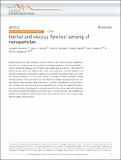Inertial and viscous flywheel sensing of nanoparticles
Author(s)
Katsikis, Georgios; Collis, Jesse F.; Knudsen, Scott; Agache, Vincent; Sader, John E.; Manalis, Scott R; ... Show more Show less
DownloadPublished version (1.778Mb)
Publisher with Creative Commons License
Publisher with Creative Commons License
Creative Commons Attribution
Terms of use
Metadata
Show full item recordAbstract
Rotational dynamics often challenge physical intuition while enabling unique realizations, from the rotor of a gyroscope that maintains its orientation regardless of the outer gimbals, to a tennis racket that rotates around its handle when tossed face-up in the air. In the context of inertial sensing, which can measure mass with atomic precision, rotational dynamics are normally considered a complication hindering measurement interpretation. Here, we exploit the rotational dynamics of a microfluidic device to develop a modality in inertial sensing. Combining theory with experiments, we show that this modality measures the volume of a rigid particle while normally being insensitive to its density. Paradoxically, particle density only emerges when fluid viscosity becomes dominant over inertia. We explain this paradox via a viscosity-driven, hydrodynamic coupling between the fluid and the particle that activates the rotational inertia of the particle, converting it into a ‘viscous flywheel’. This modality now enables the simultaneous measurement of particle volume and mass in fluid, using a single, high-throughput measurement.
Date issued
2021-12Department
Koch Institute for Integrative Cancer Research at MIT; Massachusetts Institute of Technology. Department of Biological Engineering; Massachusetts Institute of Technology. Department of Mechanical EngineeringJournal
Nature Communications
Publisher
Springer Science and Business Media LLC